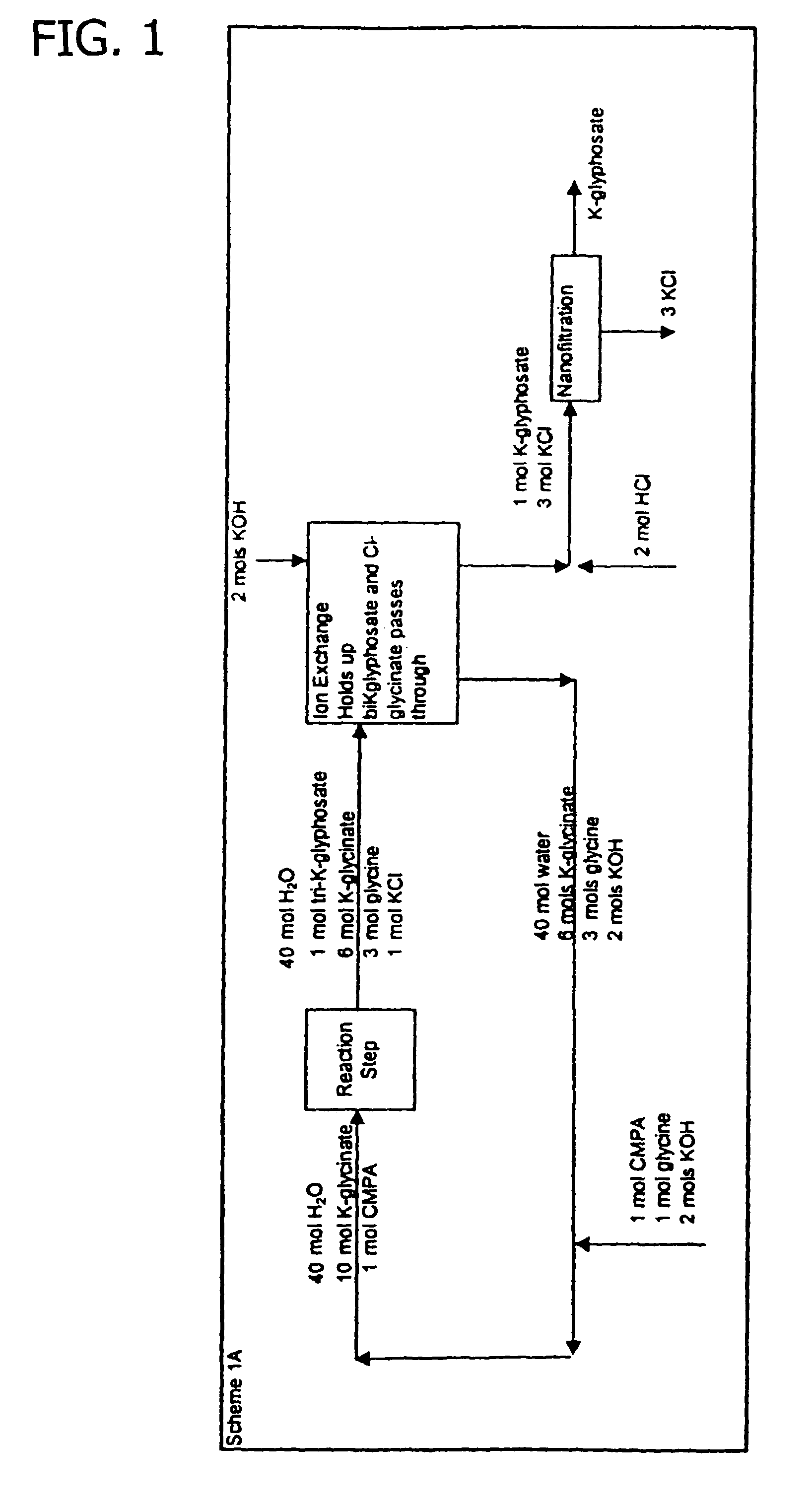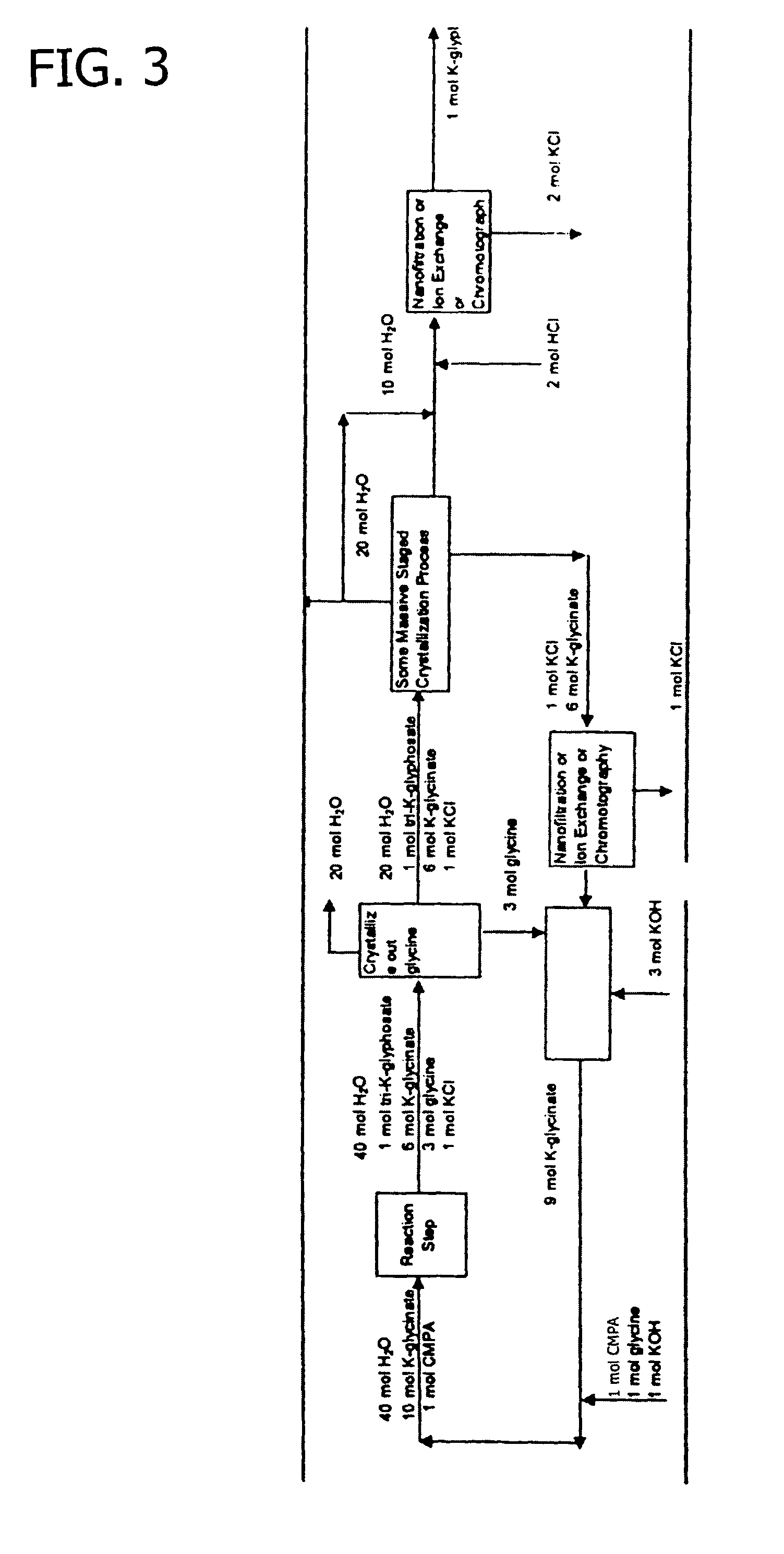Process for the preparation of N-phosphonomethylglycine and derivatives thereof
a technology of phosphonomethylglycine and n-phosphonomethyl glycine, which is applied in the field of preparation of n-phosphonomethylglycine and derivatives thereof, can solve the problems of compromising the yield of basic raw materials, creating waste disposal requirements, and products that are not readily recovered, and achieves high yields of glyphosate or glyphosate precursors. , the effect of high conversion of halomethylphosphonic acid
- Summary
- Abstract
- Description
- Claims
- Application Information
AI Technical Summary
Benefits of technology
Problems solved by technology
Method used
Image
Examples
example 1
Preparation of Glyphosate from Chloromethylphosphonic Acid (CMPA) and Glycinate
[0244]
[0245]Sodium glycinate (1.126 g) and chloromethylphosphonic acid (“CMPA”) (0.132 g) were charged to an aqueous alkaline reaction medium (0.9 g NaOH in 0.7 ml water). Reaction was conducted at a temperature of 80° C. for 16 hours. Four additional reaction runs were conducted substantially in the same manner as the first run, but with some variation in conditions. In the third, fourth and fifth runs, the charge of sodium glycinate with respect to CMPA was double that of the first and second runs. In the second and fourth runs, no base other than sodium glycinate was charged. In the fifth run, calcium hydroxide was substituted for NaOH, the temperature was increased to 95° C. and the reaction time increased to 120 hours. Yields of glyphosate, glyphosine and HMPA were measured by HPLC and NMR. The respective glycine / CMPA ratios, base identity and ratio to CMPA, CMPA conversions, reaction temperatures, r...
example 2
[0247]Further reactions runs were conducted in an aqueous alkaline reaction medium generally in the manner described in Example 1, but with variations in the water content of the reaction medium, reaction time and reaction temperature. Additives were included in certain of these runs, i.e., NaI at a concentration of 2.0% by weight in the second run and at a concentration of 0.5% by weight in the third run, tetrabutylammonium hydrogen sulfate in the fourth run at a concentration of 2.0% by weight, 15-crown-5 ether in the fifth run at a concentration of 6.0% by weight, lanthanum hydroxide in the sixth run at a concentration of 3.6% by weight and polyethyleneimine in the seventh and last run at a concentration of 1.9% by weight. Tetrabutylammonium hydroxide was substituted for NaOH as the base component in the fifth run.
[0248]The time and temperature conditions of each run, the identity of the base and molar ratio to CMPA, the ratio of water to CMPA, identity of additives, glycine conv...
example 3
Reactions of Monoethanolamine with Chloromethylphosphonic Acid (CMPA)
[0250]
[0251]Chloromethylphosphonic acid (CMPA) can be reacted with MEA in an alkaline reaction system. MEA (10-fold excess) in the presence of NaOH reacts with CMPA in water or water-organic media at temperatures of 80 to 100° C. over 16 to 22 hours to produce HEAMPA in yields of 55 to 86% based on HMPA. The reaction rate depends on the amount of NaOH (see Table 3).
[0252]Monoethanolamine (“MEA”) (0.9 g) and chloromethylphosphonic acid (“CMPA”) (0.167 g), i.e., a ten fold molar excess of MEA, were charged to an aqueous alkaline reaction reaction medium (0.132 g NaOH in 0.6 ml water). Reaction was conducted at a temperature of 100° C. for 19 hours. Three additional reaction runs were conducted substantially in the same manner as the first run, but with some variation in conditions. The time and temperature conditions, molar ratio of NaOH to MEA, CMPA conversion, HEAMPA selectivity and yield, bis-adduct selectivity, s...
PUM
| Property | Measurement | Unit |
|---|---|---|
| temperature | aaaaa | aaaaa |
| pressure | aaaaa | aaaaa |
| temperature | aaaaa | aaaaa |
Abstract
Description
Claims
Application Information
 Login to View More
Login to View More - R&D
- Intellectual Property
- Life Sciences
- Materials
- Tech Scout
- Unparalleled Data Quality
- Higher Quality Content
- 60% Fewer Hallucinations
Browse by: Latest US Patents, China's latest patents, Technical Efficacy Thesaurus, Application Domain, Technology Topic, Popular Technical Reports.
© 2025 PatSnap. All rights reserved.Legal|Privacy policy|Modern Slavery Act Transparency Statement|Sitemap|About US| Contact US: help@patsnap.com



